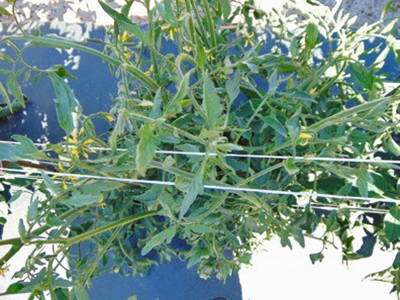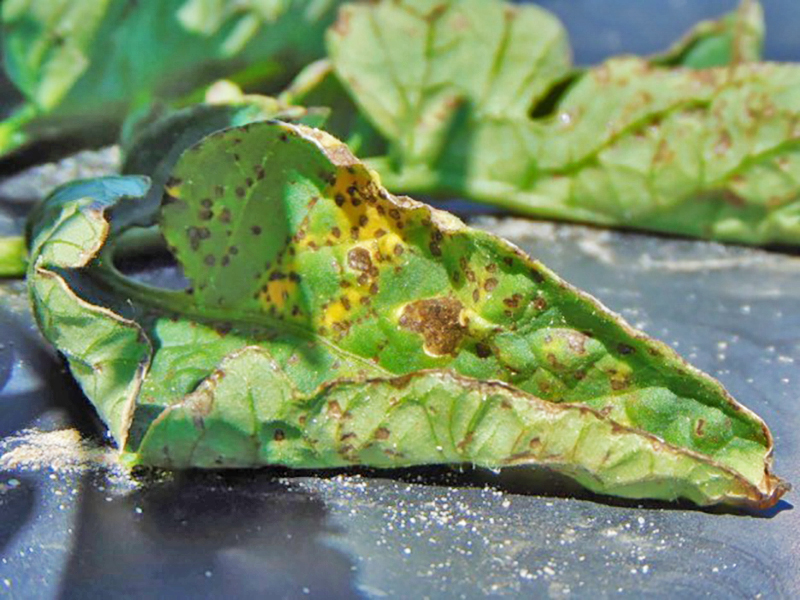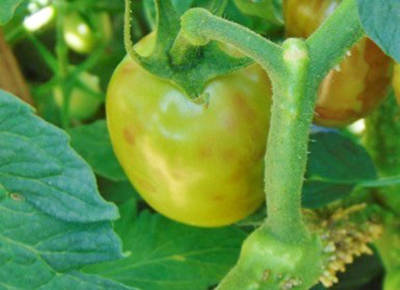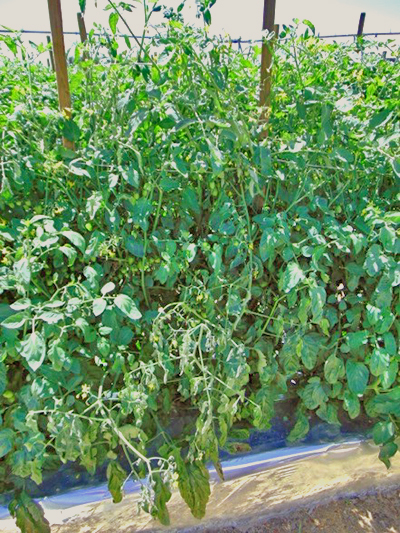Mathews Paret, Fanny Iriarte, Susannah Da Silva, Steve Olson, and Steve Hoak, UF/IFAS NFREC – Quincy
Researchers at the University of Florida’s North Florida Research and Education Center, Quincy have been surveying North Florida tomato production the last three weeks to determine the latest trends in the incidence and severity of diseases.They have also been communicating with crop consultants and producers to get their perspectives as the season progresses. At this point in the season, producers no longer have to worry about the cool weather diseases – Damping off, Bacterial speck, Alternaria stem canker, Black mold and Early blight. This year the incidence of these diseases were low. It is always good to reach the mid-point of the season with healthy plants in production.

Cucumber Mosaic Virus symptoms including stunting of the plants, short internodes and strapping of leaves.
Tomato Spotted Wilt has been seen on susceptible varieties, but the incidence has been very low. Typical symptoms in this case include ring like patterns on fruits and leaves, and purpling of leaves. Affected plants may also show wilting, vascular discoloration, and increased adventitious root formation.
Cucumber Mosaic Virus has also been seen but again the incidence has been low. Typical symptoms include stunting of the plants, short internodes and strapping of leaves.
Bacterial spot has slowly started to pick up in terms of disease incidence and severity. Two weeks ago we didn’t see any. As of this week, it has started to show up with many plants showing symptoms. Disease management options include use of a plant defense activator, Actigard (active ingredient – Acibenzolar S-Methyl) until flowering, and continued use of copper combined with mancozeb rotated with other plant defense activators, Leap (active ingredient/s – Methyl salicylate and Bacillus thuringiensis) and Vacciplant (active ingredient – Laminarin), and biologicals including Serenade (Bacillus subtilis) and Actinovate (Streptomyces lydicus). This program needs to be maintained on a 7-day interval considering that the disease severity is on the rise. Currently, disease severity is a 1-2 on a 0-5 scale. Most of the leaf lesions and some leaf blighting are on the lower plant canopy. The disease severity scale of 1-2 indicates some to many plants with low level of disease incidence and disease severity at about 10%. A 5 on this scale represents very high disease incidence and disease severity above 50%.

Early stage symptoms of bacterial spot in tomato include small lesions on leaves in the lower canopy.
Southern blight is also starting to show more as the temperature warms up but it is not expected to be a significant issue this spring. Typical symptoms of southern blight include wilting of plants and possibly a white fungal growth at the base of the plant. The growth may include sclerotia – mustard-sized structures which can be white, cream, and brown in color.
In summary, management of bacterial spot is the most important factor to consider in the coming days. Continued monitoring of late season incidences of Tomato yellow leaf curl virus (vectored by whiteflies) and target spot disease is also extremely important for successful spring and fall production seasons.
- Mathews Paret Promoted to University of Florida Plant Pathology Department Chair - July 28, 2023
- Field Performance of Plant Protectants against Bacterial Leaf Spot on Watermelon - February 11, 2022
- Using Scouting and Diagnostic Confirmation to Improve Watermelon Spray Programs in North Florida - September 25, 2020


